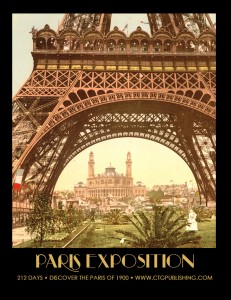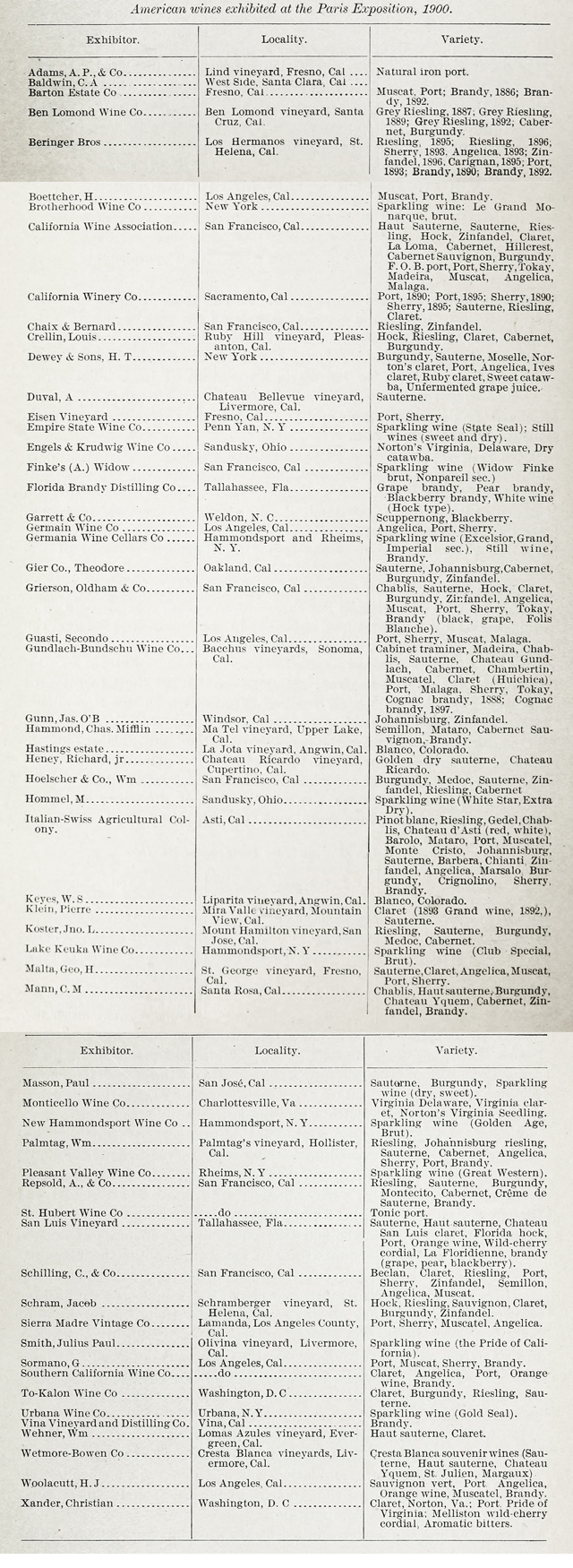American Wines at the Paris Exposition of 1900
 This is a supplement to CTG Publishing’s 212 Days – The Paris of 1900. Find out which American wineries exhibited and who received medals or other awards at the Paris Exposition of 1900.
This is a supplement to CTG Publishing’s 212 Days – The Paris of 1900. Find out which American wineries exhibited and who received medals or other awards at the Paris Exposition of 1900.
Some familiar wineries that exhibited include Beringer Brothers (bronze medal) and Paul Masson (honorable mention). If you like the technical aspects of wine, a chart of the chemical composition of the wine can be found on page 2.
The results are from the publication American wines at the Paris exposition of 1900: their composition and character (1903) or U.S. DEPARTMENT OF AGRICULTURE. BUREAU OF CHEMISTRY – BULLETIN NO. 72. by H. W. WILEY, Chief of Bureau.
GOLD MEDALS
1. California Wine Association, San Francisco, CA
2. Pierre Klein, Mountainview, CA
3. San Luis Vineyard, Tallahassee, FL
4. Sierra Madre Vintage Company, Lamanda, CA
5. W. S. Keyes, Liparita Vineyard, Angwin, CA
6. Pleasant Valley Wine Company, Rheims, NY
SILVER MEDALS
1. C.A. Baldwin, West Side, CA
2. California Winery Company, Sacramento, CA
3. Garrett & Co., Weldon, NC
4. Theodore Gier Company, Oakland, CA
5. Grierson, Oldham & Co., San Francisco, CA
6. Guasti Secondo, Los Angeles, CA
7. Richard Heney, jr., Cupertino, CA
8. M. Hommel, Sandusky, OH
9. Italian Swiss Agricultural Colony, Asti, CA
10. Urbana Wine Company, Urbana, NY
11. Engels and Krudwig Wine Company, Sandusky, OH
12. William Palmtag, Hollister, CA
13. Julius Paul Smith, Livermore, CA
BRONZE MEDALS
1. Beringer Brothers, Los Hermanoa Vineyard, St. Helena, CA
2. Brotherhood Wine Company, 332 Spring street, New York City, NY
3. Chaix & Bernard, San Francisco, CA
4. Cuesta Francisco
5. H. T. Dewey & Son, 138 Fulton street, New York City, NY
6. Empire State Wine Company, Penn Yan, NY
7. German Wine Company, Los Angeles, CA
8. Germania Wine Cellars, Hammondsport, NY
9. Gundlach Bundschu Wine Company, Sonoma, CA
10. J. O’B. Gunn, Windsor, CA
11. Charles Hammond, Upperlake, CA
12. Hastings Estate, Angwin, CA
13. Leland Stanford’s Vina Vineyard
14. Monticello Wine Company, Charlottesville, CA
15. Eepsold Company, San Francisco, CA
16. To-Kalon Wine Company, Washington, DC
17. Ch. Xander, Washington, DC
HONORABLE MENTION
1. Ben Lomond Wine Company, Santa Cruz, CA
2. Paul Masson, San Jose, CA
3. Southern California Wine Company, Los Angeles, CA
4. H. J. Woolacutt, Los Angeles, CA
“The wine jury was the largest connected with the Exposition and consisted of 81 jurors and 20 suppleants. Of these, 24 represented foreign countries and 77 represented France. The American member of the jury for wines was H. W. Wiley, and the suppleant, L. J. Vance. The wine jury was organized the latter part of May with the
following officers:
President, M. Gustave Kester.
Vice-President, Leon, Prince Galitzine.
Reporter, M. Paul Le Sourd.
Secretary, M. Raoul Chandon de Briailles.
The jury work was continued without intermission from the latter part of May to the latter part of August, before the final examinations were completed. The wines were not examined in the Exposition building, but in the large wine-testing room of the entrepot Saint- Bernard, situated on the Seine, opposite the Place Jussieu. In this large room, furnished with many tables, the jury could work in groups. Usually five members of the jury were assigned to each group, so that, as a rule, twenty groups would be working at the same time. The judgment of each group, in all cases, was final, unless some appeal should be taken to a larger part of the jury. The hours for gustation were from 9 to 12 of each working day, and each group would usually complete within this time fifty samples of wine.
The wines were judged upon a scale of numbers, of which 20 was the highest. Samples reaching 19 and 20 were entitled to the grand prix; all wines from 16 to 18, inclusive, received a gold medal; all from 12 to 15, inclusive, a silver medal; all from 9 to 11, inclusive, a bronze medal, and all from 6 to 8, inclusive, honorable mention.
In all there were some 36,000 different samples of wines to be tested by the jury, and this accounts for the long duration of the examination. Even if all twenty groups into which the jury was divided had met every day and each group examined fifty samples, it would have required thirty-six working days to complete the task. In point of fact, however, there was always a certain percentage of absentees, so that it was only on rare occasions that as many as twenty groups were working at the same time, and for this reason the examination lasted much longer than the possible period in which it could have been completed.”

